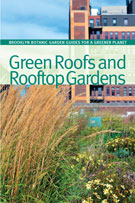 New York has more than 22,000 acres of tar and asphalt roofs, and during a summer like this, all that black acreage contributes to an already steamy, overheated city. Fortunately, more and more of those roofs are coming to life with lush vegetation. Green roofs are sprouting on top of all kinds of buildings in the city, absorbing water, filtering air, cooling temperatures, and creating vertical oases. And though it may take a while before there's a large number of miniature Central Parks up above the city streets, the movement has slowly but surely taken root.
New York has more than 22,000 acres of tar and asphalt roofs, and during a summer like this, all that black acreage contributes to an already steamy, overheated city. Fortunately, more and more of those roofs are coming to life with lush vegetation. Green roofs are sprouting on top of all kinds of buildings in the city, absorbing water, filtering air, cooling temperatures, and creating vertical oases. And though it may take a while before there's a large number of miniature Central Parks up above the city streets, the movement has slowly but surely taken root.
To tell the story of how New York's roofs are being transformed into living landscapes, the Brooklyn Botanic Garden has just published Green Roofs and Rooftop Gardens, the latest in its "Garden Guides for a Greener Planet" series. The 111-page publication, filled with vivid photos worthy of the colorful topic, is a detailed guide to everything you wanted to know about the greening of urban rooftops. The book includes the history and benefits of green roofs, the kinds of green roofs and green walls, a guide on selecting a green roof, a useful glossary, and helpful sources for more information.
In addition, the book features profiles of more than a dozen green roofs on a variety of New York City buildings, such as the U.S. Post Office's Morgan Distribution Center in Chelsea; the Brook, a public housing development in the Bronx; and Brooklyn Grange, a one-acre farm on top of an industrial building in Long Island City.
Proving that green starts at home, there's also a look at the 9,400-square-foot green roof on top of the Brooklyn Botanic Garden's very own new visitor center, where the undulating swaths of vibrant vegetation changes with the season.
Adding to the who, what, where, when, and why of green roofs, Rand is proud to have contributed the "how." In a chapter on green roof construction, Rand Project Associate and Green Team member Yessica Mariñez explains the nuts and bolts—and dirt and roots—of how a roof goes green.
Yessica, a LEED Accredited Professional who managed the green roof project Rand administered at the Fashion Institution of Technology, provides a detailed primer on the many aspects of installing a green roof, including structural considerations, the types of systems (intensive and extensive, modular and built-up), the layers that compose a green roof, vegetation, maintenance, and warranties. She also discusses why a feasibility study is critical to determine if a green roof is right for a building, and if so, what kind of system is best.
Whether you or your board is considering a green roof for your building or you're just interested in learning more about a promising development that's benefiting property owners, residents, and the city at large, Green Roofs and Rooftop Gardens is a valuable resource. (You can order a copy of the book at the Brooklyn Botanic Garden's web site.)
Going green never looked so good.
